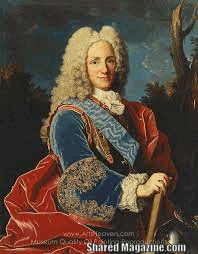“Philip V of Spain: The Complex Legacy of a Bourbon Monarch”
Table of Contents
ToggleIntroduction
In the annals of European history, the name Philip V of Spain resonates as a pivotal figure, navigating the intricate tapestry of the War of Spanish Succession and leaving an indelible mark on the Iberian Peninsula. Born in 1683 as the grandson of Louis XIV of France, Philip V ascended the Spanish throne amid a tumultuous period, shaping the destiny of a nation grappling with political strife, cultural shifts, and questions of identity.
The War of Philip V of Spain
One cannot delve into the life of Philip V of Spain without acknowledging the backdrop against which his reign unfolded—the War of Spanish Succession. Fought from 1701 to 1714, this conflict arose from competing claims to the Spanish throne, embroiling Europe in a struggle for power and balance. Philip V, the grandson of King Louis XIV, faced challenges to his legitimacy, with rival claimants vying for control.
Philip V of Spain tumultuous journey
Philip V of Spain reign, spanning from 1700 to 1724 and then again from 1724 to 1746, witnessed both triumphs and tribulations. His early years were marked by the Treaty of Utrecht in 1713, which recognized him as the legitimate Spanish king but came at the cost of significant territorial losses for the Spanish Crown. The treaty reshaped the geopolitical landscape and set the stage for Philip’s attempts to consolidate power within the diminished boundaries of his realm.
Philip V’s Battle for Legitimacy
Philip V of Spain ascension to the Spanish throne in 1700 was not without controversy. As the War of Spanish Succession unfolded, various European powers contested his legitimacy, challenging the very foundation of his rule. The conflict not only tested his mettle as a monarch but also forced him to navigate a delicate balance between asserting his right to the throne and seeking diplomatic solutions.
Philip’s ability to secure recognition through the Treaty of Utrecht in 1713 marked a pivotal moment, but it also set the stage for the challenges he would face in consolidating power within the reshaped boundaries of the Spanish realm.
Transforming Spain’s Landscape
Philip V’s reign is perhaps most notable for the sweeping Bourbon Reforms that aimed to modernize and revitalize Spain. These reforms touched virtually every aspect of Spanish society, from the centralization of administrative power to the restructuring of the military and the encouragement of economic development.
The reforms sought to propel Spain into a new era, fostering a sense of renewal and progress that would resonate for generations. While the immediate effects were significant, the long-term impact of these reforms extended well beyond Philip’s rule, contributing to Spain’s evolution as a modern European state.
Philip V as a Patron of the Arts
Amid the political turbulence, Philip V’s patronage of the arts emerged as a defining aspect of his legacy. The monarch’s appreciation for Spanish Baroque art and architecture led to the creation of enduring cultural landmarks, such as the Royal Palace of La Granja de San Ildefonso.
Additionally, his support for the Royal Tapestry Factory in Madrid showcased a commitment to fostering artistic expression. Philip V of Spain cultural endeavors not only enhanced Spain’s aesthetic landscape but also reflected his belief in the power of the arts to shape national identity.
Personal Struggles and Abdications
Philip V’s personal life was marred by recurring bouts of depression, which had profound implications for the stability of his reign. The monarch’s decision to abdicate the throne multiple times underscored the challenges he faced in reconciling the demands of leadership with his internal struggles. These moments of vulnerability humanize Philip V of Spain, reminding us that even rulers of powerful empires were not immune to the complexities of mental health.
Philip V’s Enduring Legacy
As we reflect on the reign of Philip V, it becomes evident that his legacy is multifaceted. From the geopolitical intricacies of the War of Spanish Succession to the far-reaching Bourbon Reforms and his patronage of the arts, Philip V of Spain impact on Spain was profound. His reign marked a transitional period in Spanish history, shaping the nation’s trajectory for years to come.
Philip V of Spain ability to navigate adversity, implement reforms, and appreciate the cultural richness of his realm adds layers to the narrative of a monarch whose legacy resonates far beyond the confines of his time.
The Bourbon Reforms
Despite the setbacks, Philip V of Spain implemented far-reaching reforms that would redefine Spain. Known as the Bourbon Reforms, these changes touched upon various aspects of governance, economy, and society. Centralization of power, modernization of the military, and attempts to stimulate economic growth were among the key components of these reforms. The impact of these measures would resonate long after Philip’s reign, shaping Spain’s trajectory in the years to come.
Cultural Patronage
Beyond the political and administrative sphere, Philip V of Spain demonstrated a keen interest in the arts. His patronage of Spanish Baroque art and architecture left an enduring legacy. The construction of the Royal Palace of La Granja de San Ildefonso and the establishment of the Royal Tapestry Factory in Madrid bear testament to his commitment to cultural enrichment.
Personal Struggles
Philip V of Spain reign was not devoid of personal challenges. Historical records suggest that he battled bouts of depression, leading to abdications and subsequent returns to the throne. The monarch’s internal struggles provide a humanizing glimpse into the complexities of royal life during the 18th century.
Conclusion
Philip V of Spain, a monarch caught in the crosscurrents of European power dynamics, left an indelible mark on his nation. From the tumult of the War of Spanish Succession to the enduring impact of his reforms, his legacy is a nuanced tapestry of triumphs and challenges. As we reflect on this enigmatic ruler, we are reminded that history is shaped not only by grand battles but also by the quieter moments of introspection and the pursuit of cultural and societal progress.



